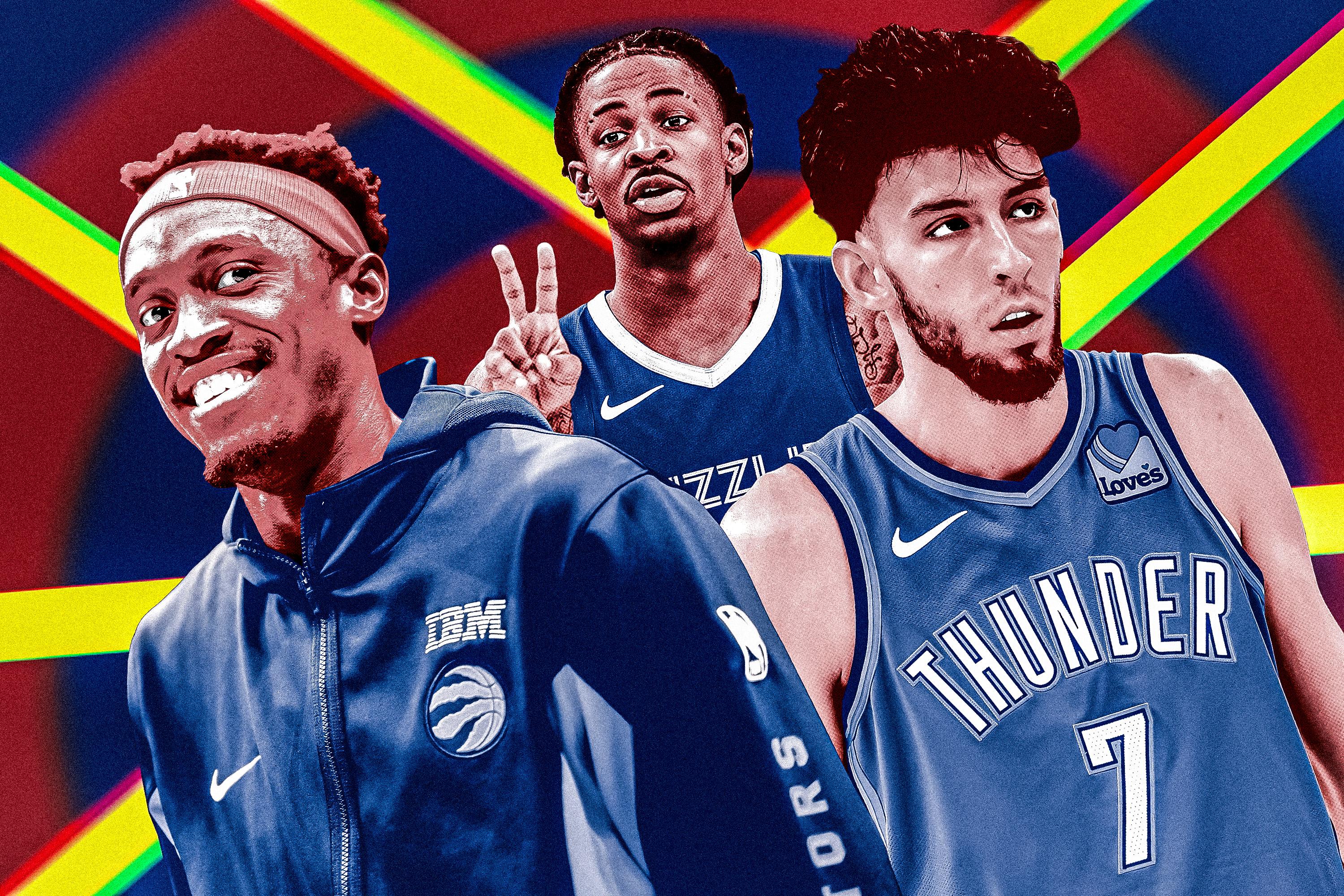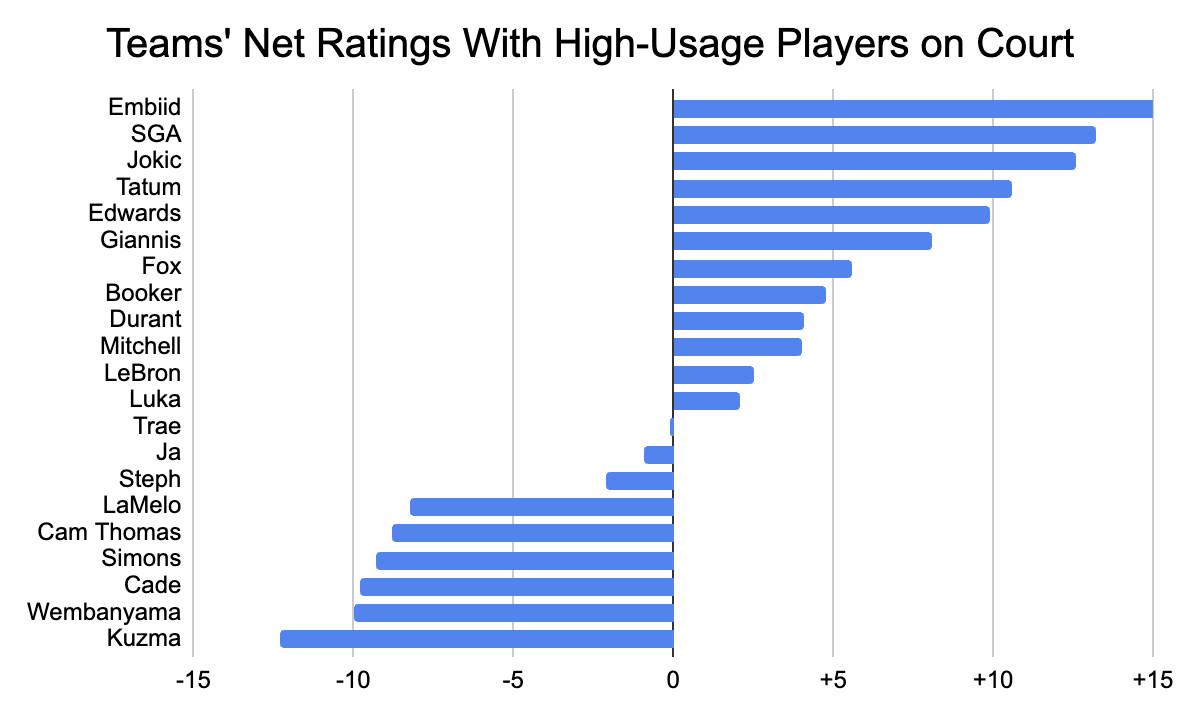
Each Wednesday of the NBA season, we’re analyzing a grab bag of topics from around the league. This week, we’re exploring a historic rookie in Oklahoma City, a potential next step for Toronto, and the return of Ja Morant. This is the Kram Session.
Under Review: Chet Holmgren Is on a Hall of Fame Pace
Chet Holmgren did a little bit of everything on Tuesday night, as his Oklahoma City Thunder beat the Boston Celtics in a statement win over a fellow Finals contender. Holmgren made three 3-pointers, sank a fadeaway from the midrange, and scooted by Kristaps Porzingis with a nifty post move. He tied a career high with seven assists. He added four blocks, including one ferocious spike of a Jayson Tatum layup attempt.
Following a redshirt season in which Holmgren didn’t play because of a Lisfranc fracture in his foot, 2022’s no. 2 pick is putting together one of the most remarkably well-rounded rookie seasons in NBA history. Holmgren has excelled right away for the youngest team in the league, on both ends of the court. And his Thunder are 23-9, the fourth-best record in the league, with the best point differential in the West and recent wins against the Celtics, Denver Nuggets (twice), and Minnesota Timberwolves.
At least as it pertains to public narratives, Holmgren doesn’t think the start to his career means anything. “I haven’t proven shit,” he told reporters Tuesday. “I’ve played 30 games. Still got a long way to go on that one.”
But even if he won’t admit it, he’s proved a whole lot about his long-term potential as a two-way star just three months into his NBA career.
Holmgren’s surface stats are impressive enough: 17.6 points, 7.6 rebounds, 2.7 assists, and 2.7 blocks per game. Only a dozen rookies since 1973-74 (the start of reliable possession data) have averaged at least 17 points and two blocks per contest: nine Hall of Famers plus Holmgren, Victor Wembanyama, and Joel Embiid.
Rookies With 17-Plus Points and 2-Plus Blocks Per Game
Yet he stands out just as much via his advanced numbers. Consider Holmgren’s ranking in a variety of player value metrics: Estimated plus-minus says the Thunder center has been a top-10 player overall this season; box plus-minus ranks him 17th; LEBRON places him 22nd. Even the most cautious of those metrics suggests that Holmgren deserves an All-Star nod next month. He’d become the first rookie since Blake Griffin (another redshirt rookie) in 2010-11 to earn that honor.
In general, it seems that folks have undersold Holmgren’s ceiling, whether because he shares a rookie class with the greatest prospect since LeBron James or because he’s teammates with a bona fide MVP candidate in Shai Gilgeous-Alexander. The natural heuristic would be to slot Holmgren in as SGA’s sidekick. But Holmgren doesn’t project as a mere second fiddle; he looks liable to join his teammate in the MVP race in the years to come.
That’s lofty praise for a player less than half a season into his pro career. But it’s a realistic prediction given Holmgren’s performance thus far. If anything, it’s a conservative prediction since Holmgren has the fourth-best box plus-minus among all rookies over the past half century. The company around him is genuinely astounding.
Best Rookies Since 1973-74 by Box Plus-Minus
Out of the previous top 15 players in rookie BPM, a whopping 13 are either Hall of Famers already or active players on their way to Springfield. Only Alvan Adams (who holds a number of Phoenix Suns franchise records) and Ben Simmons are exceptions. And that group doesn’t just include run-of-the-mill Hall of Famers, if there is such a thing. It’s a list of multi-time MVPs and inner-circle hoops legends; Holmgren’s precedents are basketball royalty.
To be fair, some caveats could further color Holmgren’s numbers: He benefits from the experience gained during his redshirt season and from playing with much better teammates than, say, Wembanyama is.
But those caveats also applied to many other rookies on that historical BPM leaderboard. Embiid and Simmons both redshirted as well (Embiid twice), and Robinson and Sabonis were older rookies. Duncan played next to Robinson as a rookie, and Magic and Bird played with three Hall of Famers apiece in their rookie campaigns.
In any context, Holmgren’s two-way play is incredible. On offense, he’s shooting 62 percent on 2-pointers and 41 percent on 4.2 3-point attempts per game, and his true shooting mark of 65 percent is the highest for any rookie in NBA history with at least an average usage rate. (Granted, he’s playing in a high-efficiency era, but even adjusting for that context, he’s in the top 10, around names like Magic, James Worthy, Robinson, Charles Barkley, and Duncan.)
That’s not just because Chet plays with one of the league’s top point guards. Holmgren’s offense is just as efficient when he plays without SGA as when he plays with him, per PBP Stats, and he’s even flashed more playmaking potential in those minutes.
Chet Holmgren With and Without Shai Gilgeous-Alexander
And on the other end, Holmgren serves as the spine of the NBA’s third-rated defense; the Thunder ranked 13th a year ago, with mostly the same personnel. Individual defense is tremendously tricky to measure, but both traditional and advanced stats adore Holmgren on that end. He ranks third in both blocks per game and block rate, and he’s seventh in the defensive components of the advanced stats EPM and LEBRON. He deserves a long look as the first rookie to make an All-Defensive team since Duncan 26 years ago.
For big men, the best way to measure defense is to look at effectiveness at the rim, and there, too, Holmgren has immediately proved he’s one of the best in the league despite his slight frame. Only Embiid has defended more shots per game at the rim, according to NBA Advanced Stats, and opponents have shot just 51 percent there when Holmgren is the nearest defender. That’s a top-10 mark, placing Holmgren next to All-Defensive mainstays like Embiid and Rudy Gobert. As a team, the Thunder lead the league in lowest opponent accuracy at the rim, per Cleaning the Glass.
(By the way, even though Holmgren is currently a sizable and justifiable favorite in the Rookie of the Year race, Wembanyama’s defensive performance leaps off the page just as much as Holmgren’s; he also deserves All-Defensive consideration. He’s tied for the league lead with 3.1 blocks per game, ranks second in defensive LEBRON behind Gobert, and has also allowed a 51 percent mark at the rim. This class of rookie centers should produce multiple perennial All-NBA candidates.)
Despite his immediate success, Holmgren, like all rookies, very much remains a work in progress; as he’d say, he’s played only 32 games, so there’s still a long way to go in his development. One area of obvious improvement is creating more of his own shots as opposed to mainly finishing. He’s made just one pull-up 3-pointer all season, while 54 of his 55 triples are of the catch-and-shoot variety. On the whole, 27 percent of his made shots are unassisted, which is a healthy rate for a center (Wembanyama’s at 26 percent) but not quite where the best offensive bigs reside.
But starting his career such that basically all of his statistical comps are Hall of Famers is a brilliant sign of potential, for both him individually and his team. Already, when Holmgren and Gilgeous-Alexander share the court, the Thunder outscore their opponents by 14 points per 100 possessions. That’s one of the 10 best marks for any pairing this season with a minimum of 500 minutes. Imagine how dominant this duo might become as Holmgren matures and the Thunder end up with two of the NBA’s best two-way players paired long term.
Best Duos by Net Rating (Minimum 500 Minutes)
Heck, that’s not merely a long-term proposition: Oklahoma City has two of the best two-way players in the league right now. Because of Holmgren’s rapid rise up the NBA ranks, the Thunder are both clearly good enough to contend for a title this season and poised to dominate the rest of the decade, too.
Zacht of the Week: 13th-Best Defense
The United Center’s visitors’ locker room hosted an impromptu party last Thursday after the Indiana Pacers used a fourth-quarter surge to beat the Chicago Bulls. Tyrese Haliburton played DJ and, along with Buddy Hield and James Johnson, led the players as they celebrated and sang along with Akon’s hit single “Locked Up.”
Haliburton was asked at his locker: Why that particular song? Because “Buddy’s been playing defense. We’ve been playing deeeee-fense!” he said with a laugh, drawing out the last word with a flourish.
That’s a new one for his team. On December 18, the Pacers allowed 151 points in a loss against the Los Angeles Clippers; James Harden celebrated by making snow angels on their home court. It was the third game in which they surrendered at least 150 points this season. Through that date, the Pacers ranked first in offensive rating but a dismal 29th on defense.
The next day was their first full practice since going to Las Vegas for the in-season tournament, and coach Rick Carlisle used the opportunity to reemphasize defensive principles. He followed soon after with a lineup change, moving offense-first options in Hield and Obi Toppin to the bench and elevating the defensive-minded Aaron Nesmith, Andrew Nembhard, and Jalen Smith to the starting lineup. (Starter Bruce Brown has also missed the past five games with a knee injury.)
As Carlisle cracked over the weekend, “Being historically great on offense is fun, but even dating a pretty girl gets boring after a while if she can’t guard anybody.”
The new focus is paying off, albeit in a small sample. Since that Clippers loss, the Pacers have been just as dynamic on offense as before but with the added benefit of ranking 13th on defense in that span. They’ve now won four games in a row, including victories over the New York Knicks and Milwaukee Bucks, to move into the top six in the Eastern Conference standings, just half a game out of fourth place.
Indiana Pacers’ Statistical Profile
The Pacers could have stayed the course, leading the league in pace and offense while largely ignoring the other end. That approach catalyzed their Cinderella run to the in-season tournament final. But the Pacers knew their hot, defense-free start was ultimately fool’s gold, especially after they slumped following their trip to Vegas.
“We had dropped four games in a row,” Myles Turner said. “The discrepancy on the boards, the defensive numbers were just really bad. It doesn’t matter how good you are offensively; defense wins championships, so we had to tweak some things.”
The new starting lineup is bigger and more physical, with only one minus defender in Haliburton. It’s still not perfect; in particular, it could use an upgrade at the power forward position (more on that below), which is now manned by Smith, the former Suns lottery pick.
But Haliburton is such a remarkable talent—he recently joined Magic Johnson and John Stockton as the only players in NBA history with consecutive 20-20 games in points and assists—that the Indiana offense should remain elite as long as he’s on the floor. And a new defensive orientation around him should set the Pacers up for more sustainable long-term success.
“History will tell you that, generally, to win a championship, you’ve got to be top 10 [in both offense and defense],” Carlisle said in Chicago. “And if you’re a top-one or -two team offensively, you’ve got to at least get in the top 15 [defensively].”
The Pacers have the top offense part locked down. And 13th, even in a small sample, fits within that top-15 threshold.
Fake Trade of the Week: Pascal Siakam to the Pacers
Welcome to 2024—and to trade season, after the Knicks and Raptors tipped things off over the weekend with a deal involving OG Anunoby, Immanuel Quickley, RJ Barrett, and others. To further get in the mood, we’ll pitch and analyze one impact deal each week leading up to the February 8 deadline. First up, we’ll propose the next step in the Raptors’ reset and improve two Eastern Conference dark horses in the process.
To Pacers: Pascal Siakam
To Magic: Buddy Hield
To Raptors: Bennedict Mathurin, Jarace Walker, Gary Harris, 2024 first-round pick (worst of Thunder, Clippers, Rockets, Jazz) via Pacers, 2025 first-round pick (Nuggets’ top-five protected) via Magic
The Pacers have reportedly displayed interest in Siakam since the summer, and for good reason: The two-time All-NBA honoree would be an excellent fit at the 4 for a team attempting to bolster its defense while not sacrificing too much of its offensive identity. Siakam’s greatest weakness is his regression as a shooter, as he’s down to 28 percent from distance this season. But playing next to Turner—a stretch 5 who’s shooting 36 percent from 3 this season—would minimize this liability, and a Siakam-Turner frontcourt would boast tremendous defensive versatility.
With Haliburton and Siakam, moreover, the Pacers would have the top-level talent to make some noise in the Eastern Conference playoffs. Obviously, they’d want some wink-wink assurances that Siakam, an impending free agent, would be open to extending or re-signing—but Indiana isn’t much of a free agent destination, so parting with some young talent to get Siakam in the door now, rather than trying to win his services as a first-time suitor this summer, might be the best way to get the big, starry wing it seeks.
The cost would likely be high—two recent lottery picks and a first-rounder in this scenario—but manageable. Walker has untapped potential befitting a no. 8 pick, but he also hasn’t forced his way into Carlisle’s rotation yet, with only 85 minutes this season. The track record for lottery picks who didn’t earn much playing time as rookies (noninjury edition) is mighty discouraging. Mathurin has legitimate scoring upside, but his development has stalled this season; his free throw rate, which was historically excellent when he was a rookie, has dropped by nearly half as a sophomore. And the draft capital suggested in this deal will end up near the end of the first round.
From the Raptors’ perspective, this deal would follow the model they preferred in the Anunoby trade. In return for one stellar two-way wing about to reach free agency, the Raptors received two young players with potential and one early second-round pick; for another stellar two-way wing about to reach free agency, this deal would net them two more young players with potential—who are less accomplished than the Knicks duo but also less experienced and expensive—and two picks in the late first round.
Finally, the Magic would upgrade from Harris, who’s shooting just 33 percent on 3s, to Hield, who’s shooting 38 percent and averaging nearly twice as many points per game. The cost would be a future first-round pick—but because it’s the Nuggets’ selection after next season, it will probably end up near the end of the first round. Given that Orlando is in the thick of the Eastern Conference playoff race, yet it ranks 30th in both made 3s and 3-point percentage, that seems like a fair price to pay.
Take That for Data: Don’t Pencil in the Grizzlies Just Yet
The Memphis Grizzlies found themselves in a daunting hole when Ja Morant returned from his 25-game suspension. At 6-19, the Grizzlies needed to go 35-22 in their final 57 games even to reach .500. That’s doable but challenging in the congested West—35-22 is a 50-win pace over a full campaign, and the Grizzlies won more than 50 games in each of the past two seasons.
Seven games into Morant’s return, the Grizzlies are on pace to make that climb. They’re 5-2 when Morant plays, though they also lost a game he missed due to illness. But the underlying numbers are less encouraging even when their star guard is in the lineup: Memphis actually has been outscored with Morant on the court this season.
The team’s biggest problem is a stuck-in-the-mud, 30th-ranked offense, which Morant hasn’t been able to unstick even though he’ll occasionally sink a game-winner or dunk on Wemby. Hampered in part by Morant’s jump-shot rust (18 percent from the midrange and 21 percent on 3-pointers), the Grizzlies have an offensive rating of just 109.5 with him on the court, which would still rank in the bottom five leaguewide.
This chart shows the on-court net rating for the highest-usage players this season. There’s a clear pattern: The best teams—the teams on track to win 50-plus games, which is the pace Memphis needs to maintain the rest of the way—overwhelmingly win the minutes with their brightest star on the court. The 76ers are plus-15 with Embiid, the Thunder and Nuggets are plus-13 with SGA and Jokic, respectively, and so on.

But only a handful of teams lose those minutes, and with the possible exception of the Golden State Warriors—who have saddled Steph Curry with underwhelming seasons from Klay Thompson and Andrew Wiggins, among other teammates—none of them are contenders. Right now, the Grizzlies with Morant are stuck in that undesirable category. Unless they start winning his minutes, by a lot, they won’t be able to maintain this pace.
Fast Breaks
1. Early Returns on the OG Anunoby Trade
It’s very silly to come to any definitive conclusions after just one game—but the very early returns suggest that I was right to call the Knicks-Raptors trade a win-win. Quickley and Barrett combined for 33 points in the Raptors’ win over Cleveland on Monday, as Toronto’s offense looked more explosive and energized than it had at any point in recent weeks.
And in New York, Anunoby scored 17 points on 7-for-12 shooting (including 3-for-6 from 3) and ably defended Anthony Edwards as the Knicks beat the West-leading Minnesota Timberwolves. Most fittingly, Tom Thibodeau kept Anunoby in the game for 20 first-half minutes and would have played him for 39 minutes total had the new Knick not fouled out early. Don’t be surprised if Anunoby leads the league in playing time over the rest of the season.
2. Awards Watch: Will the New Rules Alter the Races?
Joel Embiid returned to the court on Tuesday in a win against the Bulls. This return was important for two reasons: first, because the 76ers were just 2-2 during the reigning MVP’s four-game absence due to an ankle sprain; and, second, because Embiid has already missed seven games this season, meaning he’s potentially in danger of falling out of contention for another MVP due to the NBA’s new awards threshold.
As a reminder, the league’s new rules require players to play in at least 20 minutes of 65 games to qualify for postseason honors, except for Rookie of the Year and All-Rookie teams. (That number is lowered to 62 if players suffer a season-ending injury, and players are allowed to count two games of 15 to 20 minutes on their ledgers.) So if players miss 18 contests, they’ll no longer be eligible for honors that can reward their play and, in some cases, even influence contract terms.
With each team 30 to 35 games into the regular season, players who have missed at least seven games so far are on pace to miss at least 18 over the full season. Here’s a (surprisingly long!) list of plausible awards candidates who might run into trouble, given that context:
Awards Candidates Missing Games
Some players are already ineligible, from stars like Morant and Beal to Walker, a dark-horse Sixth Man candidate. Currently injured players like Ball, LaVine, Garland, and Mobley will be disqualified soon. And even now-healthy stars like Murray (who’s never made an All-NBA team) and Adebayo (a leading Defensive Player of the Year candidate) have uncomfortably little room for further missed games. In the first year under new rules, some awards races may come down to endurance as much as performance in a vacuum.
3. Should We Trust the Pelicans?
The Lakers have been mired in a post-Vegas swoon for weeks now, after their in-season tournament triumph, but the same can’t be said for the team Los Angeles humiliated in the semifinals. Since losing by 44 points in Vegas, the Pelicans are 8-3 with a best-in-the-West net rating of plus-13.4.
Maybe the Pelicans learned something from their embarrassing beatdown. Maybe they’re finally (mostly) healthy. Or maybe they’re showing why it’s important to look at the schedule before overreacting to a short stretch of games. Only two of the Pelicans’ wins in this stretch have come against winning teams; they defeated the Timberwolves and a Cavaliers squad missing its three best players. Otherwise, New Orleans has beaten up on a bunch of the league’s worst teams.
The good news is that blowing out bad teams is still the mark of a contender. Those wins count just as much, and New Orleans is now up to sixth in the Western standings. The bad news is that those wins don’t say all that much about the team’s chances come springtime. Over the next two weeks, though, the Pelicans play six games against opponents with winning records, plus the Warriors. That stretch should be much more informative about their actual playoff potential—and how they should behave leading into the trade deadline.

